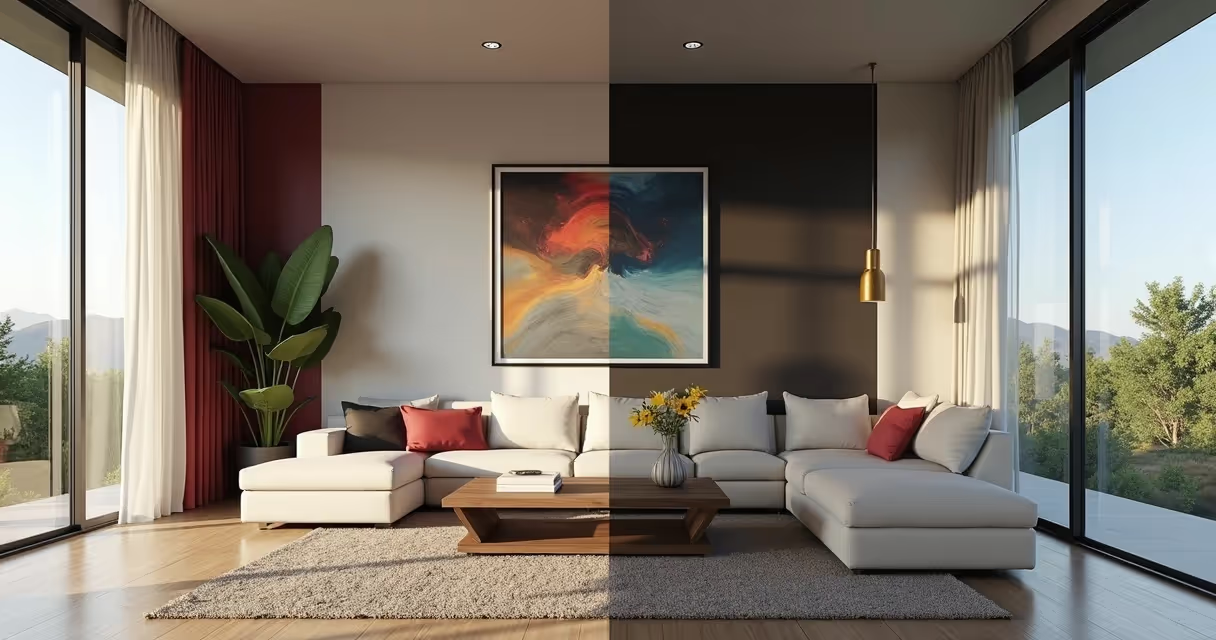Rendered design no longer has to be synonymous with sleepless nights, computers begging for help, or that classic cup of coffee that cools down before finishing the process. In the world of architects and designers, rendering a project has become almost a ritual. But what if I told you that today you can generate an award-winning rendered image in minutes, without hardware crisis or complex technical juggling? Follow me, and I will show you how Redraw opened this door, delivering architectural visualization via artificial intelligence directly through the browser.
Your project is more real than ever. Ready to impress clients and colleagues, without drama.
If you are looking to transform your ideas into realistic renderings (or simply tired of hearing that “I didn't understand” from the client), this guide is for you. Keep an eye out to the end, because there are tips, history and, of course, that invitation to get to know Redraw.
Do you know that floor plan full of doodles and dimensions? Then, when it becomes a visual image, full of shadows, textures and context, the rendered project is born. In other words, we are talking about translating your technical lines into such a rendered image, that anyone, layman or not, will look at and think: “oh, I want to live there!”
Architectural visualization ceased to be luxury and became an almost mandatory item. Clients want to understand the space, the play of light, the volume, the materials, and they want all of this without having to decipher complex plans or cuts. Have you ever seen a customer trying to understand plan facades? Not even Google Translate can do it!
It's a short journey from the technical plane to the enchantment of the eye. Designing a render not only serves to show, but to sell, convince, align expectations and... save professional skin more than once.

Let's be serious, professional rendering with AI 3D wasn't for amateurs. Only people with the patience of a monk (and a gamer's computer) faced it. We worked hours to see, at the end, the result appear slowly in blocks, as if we were using dial-up internet.
But then, here is where artificial intelligence comes in. And no, I'm not romanticizing. AI literally changed the game, bringing features such as:
Redraw, for example, took this advance and made it available: architects, designers, engineers and even those who are just starting out can render projects in the browser, in minutes. It's not science fiction, it's real life. And it's too good not to rely on a graphics card or the goodwill of someone else's computer.
Today, algorithms understand your proposal, fill spaces, adjust light, texture, and even suggest alternatives. That is, less time waiting and more time impressive.
If before the office shook at the mere hearing of the term “rendered image”, now many are already breathing a sigh of relief. Let's list what changed (and make your life easier at once):
Your time is valuable. Render to live, not live to render.
Those who work with Redraw immediately notice: delegating the heavy lifting to AI frees up energy for what matters. Experiment with ideas, test solutions, dare. And delete that old phrase from the vocabulary: “computer crashed and I lost everything”.

Let's go step by step, and there's no mystery here. Working with Redraw is less drama, more results. The flow, so simple, seems like a short movie script:
Depending on the plan, there are also advanced settings and dedicated support. Didn't like it? Ask to redo, change colors, textures, or add elements. A playground for architects and designers without the patience for slow rework.
That's the topic that sparks discussion at the office cafe. On the one hand, the purists saying that nothing beats the manual touch of traditional rendering. On the other, the modern class, who have forgotten what it is to wait three hours to see a low-resolution rendering.
Let's put it on the scale, without filter:
The future wants agility, not nostalgia.
Of course there's room for both. But if your customer keeps asking for last-minute changes, guess which model will save your deadline?
Okay, don't just throw everything into the AI and expect a miracle. A good rendered project depends on a few rules. Here's what you can't miss to keep your images from joining that shameful group of “strange renders on the internet”:
Be careful with wood textures: the customer swears they know it from afar.
With a little whim, even those who don't understand anything about architecture will look at your rendering and smile. And smiling is always great feedback.
It is the realistic or artistic visual representation created through the 3D rendering of an architectural project, whether residential, commercial or institutional. Instead of showing technical drawings, the rendered image presents the result as if it were already ready, facilitating the understanding, decision-making, and enchantment of clients or staff. It can be static or animated, bringing experiences that are ever closer to the real.
The amount varies a lot. It will depend on the complexity of the project, the desired quality, the number of images and the type of service contracted. At Redraw, for example, there are affordable plans for professionals and companies, in addition to the customization option. In other words, it is possible to find prices ranging from a few tens to hundreds of reais per image or package, but the cost-benefit ratio is certainly greater than investing heavily in your own infrastructure.
The secret lies in the sum of well-detailed input, visual references and common sense in the choice of materials and light. Define the concept of the environment, specify textures, choose strategic angles, take care of the lighting, and adjust final details carefully. Platforms like Redraw help a lot, since AI optimizes patterns and corrects possible flaws. And of course: whenever possible, review and ask for opinions before finalizing.
There are several tools on the market, each appropriate to the professional's profile and the project's demand. Some prioritize quality, others agility, but it's always important to choose the one whose result delivers the desired look within your workflow. Redraw, for example, stands out for working directly in the browser, without installation and allowing projects to be rendered with the aid of artificial intelligence in a very intuitive way.
Absolutely. The presentation of the project has an absurd visual impact, facilitates communication and reduces the possibility of rework or doubts. It helps sell ideas, guarantee approval, and create a portfolio of respect. The investment returns in professional appreciation, customer satisfaction and agility in all phases of the project. In other words: it's worth a lot!
Did you just see how the art of creating a rendered project ceased to be a technological marathon and became an almost pleasurable process? It's no exaggeration: today, rendering a project has become so accessible that it seems like a magic trick, but it's pure technology, state-of-the-art artificial intelligence and that dose of creativity that only you bring.
Redraw opens the doors for you to experiment, test, and surprise. Your portfolio thanks you, and so do your clients. What about your mental health? Well, this one may never be shaken again by a rendering that took all day to finish.
Your next project can become a reality in minutes. It just depends on you.
Access the Redraw, discover the possibilities and transform your architectural visualization into something so realistic that only the scent of the environment will be missing.